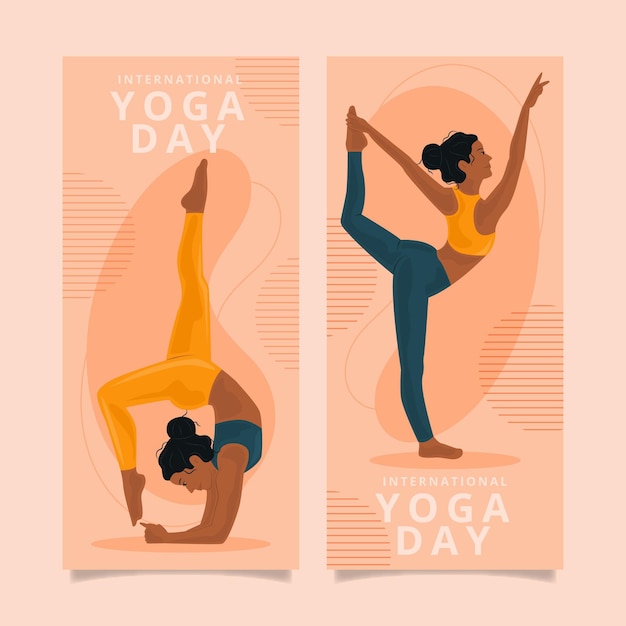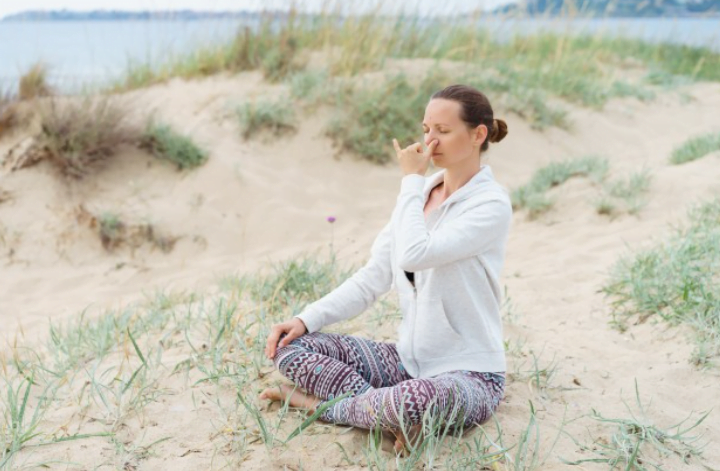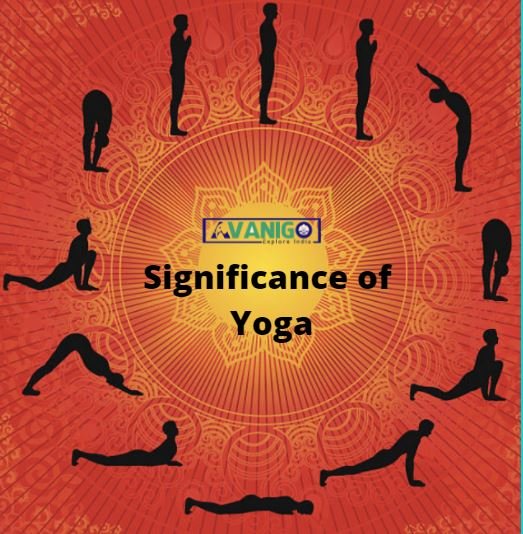Yoga is a Sanskrit word which means to attach or join. Yoga is a magical science of Ayurveda. It is the culmination of physical, mental as well as spiritual health.
There are many other forms of physical activities and exercises, but they are restricted to physical body. On the other hand, the importance of yoga is that it not only imparts physical fitness but also assures mental wellbeing. Thus, Yoga benefits are comprehensive in nature.
Importance of Yoga
Yoga unites your mind, body, and soul thus brings your life in harmony. It makes us calmer and happier person, one who is self-aware about oneself. We tend to ignore the importance of yoga. There is innumerable importance of Yoga, some of them are listed below:
Importance of Yoga in imparting all-around fitness: Yoga benefits in achieving overall fitness. The various Yoga Asanas, when practiced daily, can do wonders for your overall fitness.
Importance of Yoga in weight loss: Weight loss is a tough nut to crack and one of the yoga benefits is weight loss. People suffering from obesity always keep struggling to reduce their weight because they ignore the importance of yoga. Yoga has several Asanas which can be beneficial for people requiring weight loss.
Importance of Yoga as a Stress Reliever: We experience a lot of stress in our busy lifestyles. It is not limited to working professionals, homemakers go through a lot of stress too. Yoga can be a great stress reliever. The Yoga Asana and Pranayama have a lot of breathing exercises that can help you relax your mind. This can be a calming experience and a great stress reliever thus being a great importance of yoga.
Importance of Yoga in promoting inner peace: Yoga benefits physical, mental, and spiritual health. It brings your mind and body in unison. Yoga enhances inner peace by asanas and pranayamas.
Importance of Yoga in improving immunity: Immunity is the strength of your body to fight against illness-causing germs. You can improve it by physical exercise and following a nutrient-rich diet. Practicing yoga asanas makes you physically fit which when coupled with a good diet improves immunity and is one of the importance of yoga.
Importance of Yoga in improving self-awareness: Self-awareness is the capability to see oneself clearly and be clear about the perception of life. Self-awareness can be enhanced by meditation. One of the yoga benefits includes being a great tool for meditation in addition to being a wonderful form of physical exercise. Thus, you can improve self-awareness by Yoga.
Importance of Yoga to increase energy: All forms of physical exercise increase energy and Yoga is no exception. You can enhance your energy level and stamina by practicing Yoga every day.
Importance of Yoga in improving flexibility: Yoga asanas are excellent to improve your flexibility. It would be right to say that Yoga can be the best form of physical exercise for flexibility. Various asanas are ranging from easy to very difficult. You may start with simple stretching Yoga poses and feel the difference in your flexibility. Thus, flexibility is one of the importance of yoga.
Importance of Yoga in relieving anxiety: Anxiety is defined as the natural response of your body to stress. In our busy lifestyle, we face a lot of stress, as a result, we face anxiety issues. Yoga benefits in being an effective method to unwind and distress. We often overlook the importance of yoga for mental fitness. A session of Pranayama can help you relieve anxiety.
Importance of Yoga in Relieving Depression: Depression can be caused due to physical and mental stress. Yoga benefits as being a great stress buster. By performing yoga asanas not only help you exercise physically but also mentally.
Importance of Yoga in decreasing lower back pain: Lower back pain can be caused by sitting for long hours. Slouching on your sofa can be another reason for lower back pain. There are many Yoga Asanas devoted to strengthening your core muscles hence improving lower back pain. Thus, yoga benefits in decreasing lower back pain. Yoga poses for relief from bloating and gas
Importance of Yoga in Improving Heart Condition: Physical exercises work as a tonic for the heart. You do a lot of good for your heart if you exercise regularly. Yoga is a great form of physical exercise. Thus, yoga benefits in improving your heart condition.
Importance of Yoga in stimulating brain function: Yoga Asanas or Pranayama focus on breathing. These yoga asanas can improve mental alertness. As a result, the brain can enhance its function by regular practice of Yoga. Thus, yoga benefits in stimulating brain function.
Importance of Yoga in increasing focus, concentration, and attention: Yoga is a great tool for improving mental and physical health. It increases the alertness of your senses. It reduces stress and anxiety thus your mind is more relaxed. Thus, yoga benefits by improving your concentration and focus.
Importance of Yoga by improving balance and posture: Yoga asanas teach you to control your body to hold and breathe in a particular pose. This as a result improves your body’s overall balance. Thus, yoga benefits by improving flexibility, and with regular practice, you can enhance your body posture.
History of Yoga
India is the birthplace of yoga. The history of Yoga dates back to more than 5000 years. It is believed that it may have existed 10000 years back, however, the exact date is not known. One of the reasons for this is that the teachings were oral.
Yoga originated in the Indus valley civilization around 3000 B.C. It was mentioned in the Rig Veda as well as the Upanishads. The spiritual sense of Yoga was furnished in many epics in Sanskrit, dating back to the later part of the 1st millennium. B.C. The philosophical system of yoga connects the human spirit and the divine spirit. Yoga Sutras is the first significant piece of art by Patanjali. It dates back to the 2nd century B.C. Maharishi. Patanjali is considered to be the Father of Yoga.

According to ancient Hindu texts, an ethical behaviour clears the conscience. Corrective meditative poses help to stabilize the body while controlling the breath through yoga steadies the nervous system.
Yoga in Ancient Hindu Texts
The importance of Yoga is found in every Indian spiritual and religious literature. Also, the integrative Yoga approach is found in Indian music, dance, science, literature, drama, and medicine.
- The importance of yoga according to Yoga Sutras of Patanjali (4th Century B.C.):
Yoga Chitta Vritti Nirodhah – Yoga is calming down of the fluctuations or patterns of consciousness. Thus, mentioning the importance of yoga.
- The importance of yoga according to Katha Upanishad (5th century B.C.)
When the five senses, along with the mind, remain still and the intellect is not active, it is known as the highest state. They consider yoga to be firm restraint of the senses. Thus, mentioning the importance of Yoga.
- According to Pancarthabhasya on the Pasupatasutra (4th century C.E.)
In this system, Yoga is the union of the Lord with self.
- According to Linga Purana (7th to 10th century C.E.)
Yoga means Nirvana, the condition of Shiva. The ultimate aim of Yoga according to Hindu mythology is to attain ‘Moksha’. Moksha is termed as the liberation of one’s soul from the cycle of death and rebirths. This is an ancient Hindu traditional philosophy.

The concept of Moksha is also found in Buddhism, Jainism, and Sikhism. However, one must remember that all these faiths have evolved from Hinduism. Some other terms such as Nirvana and Mukti are also used interchangeably for Moksh. It is the final goal of human existence as per Hindu mythology.
Mention of Yoga in Vedas
The Vedas cannot exist without Yoga. Vedas preach about spiritual knowledge through meditation. The root of meditation lies in Yoga or ‘Dhyan’.
People in recent times fail to realize Yoga is more than asanas or physical postures. This is because we conceptualize Yoga according to modern times. The asanas or postures do not have a major role in Vedas or any classical texts. Even the Yoga sutras which are considered the best work of yoga constitute only 2 out of 200 sutras to them.
The Vedas emphasize Mantra Yoga. The Yoga sutras also give importance to Pranava or the Divine word. It is considered as a prime principle of Yoga practice. The Vedas are in the form of Mantras, their recitation is a part of Mantra Yoga. The Gayatri mantra is a Vedic Mantra, it is quite commonly recited even to this day. The Sanskrit language has its origin in Vedas.
Mention of Yoga in ancient Hindu Texts
Yoga is commonly referred to in all sacred Hindu Texts. Be it the Tantras, Puranas, Mahabharata, or Vedas.
The Bhagavad Gita, considered to be one of the most sacred Hindu epics, has many Veda teachings. It emphasizes the path of Moksha and teaches self-realization. It is dedicated to Lord Krishna’s dialogues to Arjuna, teaching him the righteous path of life and path of Moksha.
Bhagavad Gita states that “This yoga should be practiced with firm determination and perseverance, without any mental reservations or doubts.”
The Mahabharata, precisely Bhagavad Gita has dedicated sections on Yoga. According to Bhagavad Gita, Lord Krishna tells Arjuna, “Be steadfast in Yoga, O Arjuna. Perform your duty and abandon all attachment to success or failure. Such evenness of mind is called Yoga.”

Vedic Yoga is the origin of Yoga. The Rig Veda has almost a thousand hymns, it is one of the longest Yoga texts. It consists of the teachings of many Rishis and Yogis. To this day, many Yoga and Veda preaching are in vogue.
The yoga practices had begun with the start of civilization. It existed even before the first religion was born. According to ancient Hindu texts, Shiva is the first yogi. Another name for Shiva is Adiyogi meaning the First Guru or Adi Guru.
Hindu religious texts believe in the legend that Lord Shiva delivered his knowledge to the legendary ‘Saptarishis’, commonly termed as ‘Seven sages’. The sages are believed to spread the knowledge to different parts of the world. However, in India, it developed into its most profound form.
The Upanishads preach the main principles of Vedantic philosophy and Samkhya. They are the core systems used in Yoga. The Upanishads deal with the theme of Yoga as Om, Mantra, Meditation, Control of mind, Knowledge of Purusha, and Values of Yoga. Thus, the Upanishads describe the yoga benefits at large.
The Bhagavad Gita explains in detail the concept of Gyan Yoga, Bhakti Yoga, and Karma Yoga. The 3 types of Yoga are the highest examples of human wisdom.
The numerous seals and fossils remain with Yogic motives and figures found in the remains of Indus Valley civilization, prove the presence of Yoga during those times. The seals of idols show the presence of Tantra Yoga.
According to Hatha Yoga Pradipika, “When the breath wanders the mind is also unsteady. But when the breath is calmed the mind too will be still, and the Yogi achieves a long life. Therefore, one should learn to control the breath.”

In ancient times, Guru teachings were considered to be of high importance. Accordingly, pranayama and other asanas were practiced daily. Sun was considered to be of very high significance. The practice of Surya Namaskar has assumed prominence during those times. It was also during this time that Maharishi Patanjali created Yoga Sutra which is considered to be the finest piece of Yoga literature to date.
Evolution of Yoga
Classical period 500 B.C. to 800 A.D.
It is the most prominent period for the history and development of Yoga. It is during this time that Yoga Sutra and Bhagavad Gita came into existence. This was the era of Mahavira and Gautam Buddha. Their teachings Pancha Mahavrata and Eightfold path were predominantly based on the significance of yoga.
The commentary on Yoga sutra Vyasa was also compiled during this period.
People continue to follow these types of Yoga to date to attain peace. During these times Yoga Sadhana came into existence depicting the importance of mind and body union through Yoga.
Post-Classical Period 800 A.D. to 1700 A.D.
The teachings of Acharya Trayas, Adi Shankaracharya, Ramanujacharya, Madhavacharya came into existence during this period. Other significant works were the teachings of Surdas, Tulasidas, Mirabai, and Purandaradasa. Hatha Yoga developed its prime during this period.
Modern period 1700 – 1900 A.D.
This was the modern period of Yoga. In this period significant Yogacharyas gained prominence, namely Ramana Maharshi, Ramkrishna Paramhansa, Paramhansa Yogananda, Vivekananda, etc. In this period Vedanta, Bhakti Yoga, Raja Yoga, and Hatha yoga flourished.
In recent times yoga practices are looked after as a physical form of exercise. People started following it for yoga health benefits, stress relief, and relaxation. Indian Yogis have gained significance and spread their teachings to various parts of the world. Eventually, yoga gained popularity in developed countries. Countless Yoga schools are jotting in every corner of the world.
Many Indian Yogis are responsible for the acceptance of Yoga at a very grass root level. Swami Vivekananda is furnished with the credit of spreading the message of Yoga to the West.
In India, Yoga came into vogue mainly in the last decade, the main credit for it goes to Swami Ramdev. He has been an inspirational figure for millions of Indians who have accepted his Yoga Asanas and Pranayama in their day to day life. He is synonymous with teaching Yoga Asanas along with providing Ayurvedic cures for all kinds of illness starting from common cold to Cancer and Blood sugar.

When in International Yoga Day?
International Yoga Day is celebrated on June 21st every year. According to our PM Shri Narendra Modi, “Yoga is India’s gift to the world.” He has been an active promoter of Yoga.

Categories of Yoga
There are four major categories of Yoga.
- Karma Yoga
- Bhakti Yoga
- Gyana Yoga
- Kriya Yoga
Simple Yoga poses
Surya Namaskara
There are many Yoga poses which one can practice and benefit from the comfort of home. One of the classical Yoga poses is the Surya Namaskara. The beauty and the importance of yoga poses can be observed in the results of practicing Surya Namaskara.
Surya Namaskara or sun salutation is devoted to the Sun God. This yoga asana is considered to be the Mother of all asanas. It is a set of 12 yoga poses combined to form one asana. It is cardiovascular exercise. Surya namaskar benefits us by rendering a positive impact on the body as well as the mind.

If you are looking for beginning with common yoga poses, get started with Surya namaskara. It is an ancient form of yoga asana and with time many versions have been developed. However, it is advisable to stick to any one variant and its sequence.
Pranamasana or Prayer pose
- The first step is to stand on the edge of the mat.
- Stand keeping your feet together.
- Balance your weight equally on both feet.
- Expand your chest and relax your shoulders.
- Inhale and lift your hands.
- Bring your palms together in front of your chest in a prayer position exhaling while doing so.
Hasta Uttanasana or Raised Arms pose
- Take a deep breath and lift your arms.
- Keep your hands tucked near your ears.
- Try to stretch the whole body up. Feel the stretch from the heels to the tips of the fingers.
- Push your pelvis forward a bit.
- Do not bend backward, try to reach with your fingers.
Hastapadasana or Standing forward bend
- The first step is to bend forward from the waist.
- Keep the spine erect and breathe out while doing so.
- After exhaling completely, bring your hands down touching the floor beside the feet.
- You may bend your knees if your hands are unable to reach the floor.
- Try to straighten your bent knees keeping your hands fixed to the ground.
Ashwa Sanchalasana or Equestrian pose
- The first step is to push your right leg back as far as possible, breathe in while doing so.
- Bring the right knee to the floor as far as possible.
- Push your right leg back as far as possible while breathing in.
- Place your right knee to the floor and look upwards.
- Ensure that your left foot is exactly in between the palms.
Dandasana or Stick Pose
- Place your left leg back.
- Breathe in while doing so.
- Try to place your entire body in a straight line.
- Ensure that during this pose your arms are perpendicular to the floor.
Ashtanga Namaskara or Salute with eight parts or points
- Place your knees down to the floor gently while exhaling.
- Place your hips slightly backward
- Rest your chest and chin on the floor while sliding forward.
- Raise your back portion a little.
- 8 parts should touch the floor i.e. 2 hands, 2 feet, 2 knees, chest, and chin.
Bhujangasana or Cobra pose
- The first step is to slide forward and raise the chest in a Cobra pose.
- Your elbows can be bent and shoulders away from the ears.
- Look upwards towards the ceiling.
- Push the chest gently forward while inhaling.
- Push your navel down gently while exhaling.
- Your toes must be tucked under.
- Do not force your body, stretch it only as much as it can take.
Adho Mukha Svanasana or Downward facing dog pose
- The first step is to breathe out and lift the hips.
- Also, lift your tailbones to bring the body in the shape of an inverted ‘V’.
- Ensure that your heels are on the ground.
- Gently lift your tailbone.
Ashwa Sanchalanasana or Equestrian pose
- The first step is to breathe in.
- Bring your right foot forward and place it exactly in between the two hands.
- Position your left knee on the floor.
- Press your hips down and look upwards.
- Ensure that your right calf is perpendicular to the floor.
- Try to gently push your hips down towards the floor.
Hastapadasana or Standing forward bend
- The first step is to bring your left foot forward while breathing out.
- Place your palms on the floor.
- Bend your knees if required.
- Gently straighten your knees.
- Try to touch your nose to your knees.
- Keep breathing.
Hasta Uttanasana or Raised arms pose
- Roll the spine up while breathing.
- Raise your hands.
- Bend a little backward.
- Push your hips slightly outwards.
- Ensure that your arms are beside your ears.
- The main concern of this pose is to stretch up more rather than stretching backward.
Tadasana or Mountain Pose
- The first step is to straighten your body.
- Exhale while doing so.
- Bring the arms downwards.
- Hold this position and relax.
- Take gentle breathes and feel your entire body.
These 12 sets of asanas make up the Surya Namaskar. It is preferably advised to be performed during sunrise.

However, it may be done during any part of the day depending on your convenience. Carry out the exercise in the open for maximum benefits. The set of 12 poses can be repeated any number of times. It is advisable to change your leg for the next round of sun salutation.
Benefits of Surya Namaskar
- It maintains cardiovascular health.
- It keeps the nervous system stimulated.
- It flexes, tones, and stretches the muscles.
- It is a good exercise for weight loss.
- It strengthens the immune system.
- It enhances brain functions.
- It improves overall health.
- It provides strength to the body and relaxes the mind.
- It is an overall exercise that benefits the entire body.
How to do Pranayama breathing exercises?
The term Pranayama is made up of 2 words namely ‘Pran’ meaning life and ‘Yam’ meaning practice.
Pranayam or breathing exercise is based on the science of breathing. It gives you both physical and mental benefits. It may sound simple but the simple art of controlling your breath can do wonders for your mind and body. The exercise involves breathing in patterns.
While doing Pranayama, you inhale, exhale, and hold your breath in a specific sequence. Another important aspect is that you have to conduct the entire set of breathing while maintaining a particular physical posture. This together makes Pranayama a very effective physical and mental exercise.

Importance of yoga through Pranayama
If you are doing Pranayama regularly, you are bound to be greatly benefitted. Some of the benefits are enumerated below.
- Importance of yoga through Pranayama in weight loss.
Staying fit is everyone’s concern these days. Mostly, youngsters are concerned with belly fat. Pranayama done in the correct posture can help you burn the excess fat in your abdomen area.
- Importance of yoga through Pranayama in benefiting lungs.
Your lungs are a very important organ of the body. It purifies the air you breathe. Inhaling fresh and pollution-free air helps rejuvenate your lungs. There is hardly any physical exercise for the lungs which focuses on breathing. Pranayama is one such breathing exercise. It is concerned with inhaling, exhaling, and holding of breath in a required sequence. It is the most effective exercise for your lungs that you can perform from the comfort of your home.
- Importance of yoga through Pranayama to cure blocked nasal passages and sinuses
Pranayama is very effective in the treatment of blocked nasal passages. It mechanically cleans the blockage by rhythmic and deep inhaling and exhaling. It can also clean the sinus cavity. It helps in making the nasal passage free of allergies. Thus, people suffering from chronic headaches, nasal blockages, and running noses due to sinusitis can be greatly benefitted.
- Importance of yoga through Pranayama for cardiovascular health
Pranayama helps in relieving stress. It lowers the heart’s blood pressure and improves circulation. Hence, it is good for cardiovascular health.
- Importance of yoga through Pranayama for skin
Performing regular breathing exercises increases the intake of oxygen in your skin. This in turn improves your skin.
- Importance of yoga through Pranayama to improve digestion
Gastritis, acidity, and digestive disorders are very common these days. According to research, the bowel movements are related to stress. Pranayama helps in improving digestion by reducing stress levels.
- Importance of yoga through Pranayama to vitalize immunity
Pranayama helps reduce stress in your body. According to research, a stress-free body is more potent to fight against diseases. As a result, the regular practice of Pranayama improves immunity.
- The importance of yoga through Pranayama enables detoxification
Pranayama helps you calm your mind and body. With exhaling of every breath, you not only exhale air but also impurities from your body. Thus, it enables detoxification.
- Importance of yoga through Pranayama to enrich concentration
Pranayama is a wonderful exercise that helps you calm your mind and body. It helps you relieve stress, anxiety, decrease heart rate, and improve blood circulation. Besides, when you inhale and hold your breath you increase the oxygen supply to your brain. It results in improving concentration.
Tips to do Pranayama
While doing Pranayama your posture is very important. The benefit of the exercise depends on your sitting posture.
- There are broadly 2 major poses from which you may choose for your exercise.
- Vajrasana or sitting on your knees.
- Sitting cross-legged like in Lotus position.
- You can try any of the two sitting poses for the exercise and continue what suits you the most. The ultimate goal is to keep your spine upright.
Also, there is no thumb rule for the length of the exercise. It depends on your comfort.
- Start with a 1-minute long breathing exercise. You can increase the time as and when you feel comfortable.
KapalBhati Pranayama
The literal meaning of the exercise is ‘skull shining breath.’ It is a good exercise for toning the abdomen. It is also helpful for clearing of blocked nasal passages and treating sinuses.

There are many variations to the Pranayama however, the basic steps are described below.
- The first step is to be in a seated position.
- Place your palms on the knees.
- Ensure that your palms are facing upwards.
- Keep your attention on the belly region.
- Inhale deeply and slowly filling both the lungs with air.
- Exhale air in short bursts followed by automatic inhalation.
- The exhalation should be such rapid that a hissing sound is produced when you do it.
- Imagine that you are exhaling all toxic from your body along with the air. Also, while inhaling air, you are absorbing all the good from nature.
- Do it for as long as you feel comfortable.
- One round of Kapalbhati makes you feel energized for the entire day.
Anulom Vilom Pranayam
This is a very effective exercise for relief from stress and anxiety. It is also known as ‘Nadi Shodhana’. Practicing it in the morning with an empty stomach and fresh air can do wonders for your body.

The basic steps to perform the exercise are given below.
- The first step is to be in a seated position.
- Close the right nostril from the right thumb.
- Breathe in gently and deeply from your left nostril to feel your lungs.
- After breathing in completely from the left nostril, close it from your middle finger and ring finger.
- Remove your thumb and breathe out from your right nostril.
- After breathing out completely, breathe in from the right nostril itself.
- Close your right nostril and breathe out from your left nostril.
- Repeat the pattern for as long as you are comfortable.
There are several other Pranayamas and their variations, namely.
- Dirgha Pranayama
- Ujjayi Pranayama
- Simha Pranayama
- Bhastrika Pranayama
- Bahya Pranayama
- Bhramari Pranayama
- Udgeeth Pranayama
- Pranav Pranayama
You may include any of the above mentioned Pranayamas in your regular workout routine. They benefit you to improve all aspects of emotional, physical and mental health.
Yoga is a universally accepted form of physical exercise performed for improving health and fitness. However, the ultimate aim of Yoga is much deeper. Even though Yoga emerged in the Hindu philosophy, it is accepted and practiced today by believers of all faiths. The actual secret behind yoga is not related to any religion, it is related for the spirit and soul in everyone of us.

